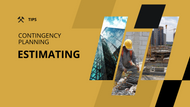5 Trusty Tips for Contingency Planning in Construction Estimating
Jul 2nd 2023
Contingency planning is an important part of any construction project. It can help you avoid unexpected costs and delays and prevent missing out on opportunities that would have saved you money in the long run. However, most people don't take the time necessary for good contingency planning because they think it's too complicated to do correctly. If this sounds like you, read on to discover key construction estimating tips on how to create a contingency plan that works well for them.
1.Conduct a Thorough Risk Assessment
Before commencing any construction project, you should conduct a comprehensive risk assessment. Identify potential risks such as weather conditions, material availability, labor shortages, design changes, and regulatory compliance issues. By assessing these factors early, you can develop robust contingency plans addressing each risk.
This way, you can make more informed decisions about what products or services are needed for your project and how much money they'll cost.
2.Allocate Adequate Time and Resources
Contingency planning requires careful allocation of time and resources. Set aside sufficient time during the estimating phase to thoroughly evaluate potential risks and develop contingency strategies accordingly. Additionally, allocate appropriate resources to ensure that contingency plans can be implemented effectively when needed.
You should include a contingency allowance in your estimates to account for unexpected events or changes during construction projects. This allowance should be a percentage of the total project cost and can vary depending on the complexity of the project and industry standards.
3.Collaborate with Stakeholders
Stakeholders are the people who have a vested interest in your work. Stakeholders can be clients, project managers, architects, engineers, and subcontractors. You should communicate with them regularly to ensure all parties are on the same page.
When you collaborate with stakeholders, you can better understand their needs and expectations. This will help you make accurate and reliable estimates for your projects.
4.Regularly Review and Update Contingency Plans
When it comes to contingency planning in construction estimating, it's essential to review your plans regularly and update them as necessary.
One of the best ways to do this is by creating a checklist you can use every time you plan a project. This will help ensure that nothing gets overlooked and that you're always prepared for any extra costs that might arise during the project.
5.Continuously Monitor Risks
One of the best ways to avoid a problem is to anticipate and plan for it in advance. When planning your construction estimating, you should always look for risks that could affect your project's costs.
This can include anything from unexpected weather conditions to logistical issues like insufficient labor or materials. Once you identify risks, you can work to mitigate them by adjusting your timeline or budget accordingly.
6.Use Data Analytics Tools
Data analytics tools can help you identify problems with your estimates so that you can fix them before they become too costly for your business.
They allow companies in all industries to collect data from multiple sources and analyze it in real-time, giving them deep insights into their operations and enabling them to make better decisions about how best to proceed with each project they undertake.
Contingency planning is an indispensable aspect of construction estimating that enables contractors to navigate unexpected challenges successfully. Implementing these tips will help you stay prepared for unforeseen circumstances and ensure the successful completion of your projects within budget and schedule.
Image credit: Canva

